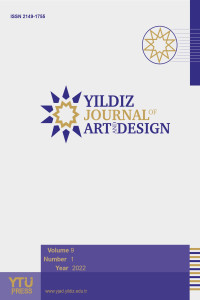Sanat ve Tasarımda Gerçeküstü Mizah: Marx Ernst ve Jan Lenica
Görsel mizah, tasarım ve sanatçılar tarafında kullanılan önemli araçlardan birisidir. Sanat tarihçileri ve düşünürler mizahın daha çok edebi, hikâye ve roman gibi alanlarda analizler, yorumlar ve araştırmalar yapmıştır. Fakat özellikle gerçeküstü mizahın sanat ve tasarım alanındaki ilişkileri bağlamında, birbirlerinden farlılıkları ve benzerlikleri yönünde, analizler ve araştırmalar kısıtlı kalmıştır. Bu araştırmanın amacı, sanat ve tasarımda görülen absürt ve saçma özelliklere sahip gerçeküstü mizahın, sanat ve tasarım alanlarında nasıl ve niçin kullanıldığını analiz ederek, bulgular ve sonuçlar çıkarmaktır. Araştırmada görsel gerçeküstü mizahın saçma, absürt ve tuhaf yönlerinin dada ve gerçeküstü sanatçılarının çalışmalarında sık görülen bir yaklaşım olduğu görülmüştür. Konunun somut halde tartışılması ve analiz edilebilmesi için, gerçeküstü sanatın önemli temsilcilerinden Max Ernst’in çalışmaları bu bağlamda incelenmiştir. Ersnt’in çalışmalarındaki figüratif çalışmalarda görülen tuhaf ve absürt olguların oluşturduğu beklenmedik sürprizlerin gerçeküstü mizahın temelini oluşturduğu tespit edilmiştir. Diğer taraftan özellikle afiş tasarımı alanında önemli isimlerden Jan Lenica’ın çalışmalarında görülen benzer gerçeküstü ve tuhaf figüratif unsurların belli bir somut hikâyeyi anlatmak için iletişim oluşturmak için kullanıldığı görülmüştür. Görsel gerçeküstü mizahın sanat ve tasarım bağlamında özellikle Ernst ve Lenica’nın çalışmaları çerçevesinde yapılan analizler ve tespitler sonucunda, kullanılan görsel dilin ve fikir çözümlemelerin paralel bir yapıda olduğu görülmüştür. Fakat diğer taraftan sanat ve tasarım alanlarının amaçları farklı olması sebebiyle, gerçeküstü mizahın sanatta kullanılması daha muğlak ve belirsizlik bir anlayışla ele alınırken, tasarımda benzer görsellerin iletişim oluşturmak için spesifik bir kavrama dönüştürüldüğünü söylemek mümkün. Araştırmada karşılaştırmalı metodoloji ile elde edilen bu araştırmadaki bulguların, akademik araştırmacılara, sanatçılara ve tasarımcılara faydalı olacağı düşünülmektedir.
Surreal Humor in Art and Design: Marx Ernst and Jan Lenica
Visual humor is one of the important tools used by designers and artists. Art historians and thinkers have mostly analyzed, commented on, and researched humor in literary fields, such as stories and novels. However, in the context of the relationships of absurd and absurd humor in art and design, the analyses and research on their differences and similarities have been limited. The aim of this research is to analyze how and why absurd humor, which has absurd and absurd characteristics in art and design, is used in the fields of art and design, and to derive findings and results. In the research, it was seen that the absurd, absurd and strange aspects of visual absurd humor are a common approach in the works of dada and surrealist artists. In order to discuss and analyze the subject in a concrete form, the works of Max Ernst, one of the important representatives of surrealism, were examined in this context. It was determined that the unexpected surprises formed by the strange and absurd phenomena seen in Ernst's figurative works constitute the basis of absurd humor. On the other hand, it was seen that similar surreal and strange figurative elements seen in the works of Jan Lenica, an important name in poster design, were used to create communication to tell a specific concrete story. In the analyses and findings made within the framework of the works of Ernst and Lenica in the context of visual absurd humor in art and design, it was seen that the visual language used and the idea analyses have a parallel structure. On the other hand, since the purposes of art and design fields are different, the use of absurd humor in art is handled with a more vague and uncertain understanding, while similar images in design are transformed into a specific concept for communication. It is possible to say that the findings obtained in this research with the comparative methodology in academic studies on the relationship between art and design will contribute to the literature on the subject.
___
- Bradley, F. (1997). Surrealism. London, Tate Gallery Publication.
- Janis, H and Blesh, R. (1967). Collages: Personalities, Concepts, Techniques. New Jersey. Ambassador Books, Ltd.
- Wollheim, R. (1971). Freud. London. Fontana Press.
- Robinson, M. V. (1991). Humour and the Health Professions. New Jersey. Slack Incorporated.
- Auner, Ziv. (1984). Personality and Sense of Humor. Springer Pub Co. Michigan University.
- Breton, B. (1997). The Anthology of Black Humor. Translated from French to English by Mark Polizotti, City light Books, San Francisco. USA
- Gatt, G. (1968). Max Ernst. Hamlyn publication. Florence, Italy.
- Avalon, H. F.C. (1991). View: Parade of the Avant-Garde 1940-1947. NThunder’s Mouth Press. New York.
- Russel, J. (1967). Max Ernst: Life and Work. Thames and Hudson, London.
- Spies, W. (1991). Max Ernst: A Retrospective. Tate Gallery. London.
- Schneede, M. U. (1967). The Essential Max Ernst. Thames and Hudson. London.
- Turpin, I. (1979). Ernst. Phaidon Press Limited. Paris.
- Stephenson, R. (1974). “Jan Lenica’s Animated Film” in Idea Magazine, No: 122. Japan.
- Lenica, J. (2002). Labirynt. Poznan Museum. Poznan.
- Mount, C. (200). Rafal Olbinski and The Opera. CT, Nahan Editions. Stamford.
- Freud, S. (1976). Jokes and Their Relation to the Unconscious. Pelican Publication. London.
- Image 1: https://www.reproduction-gallery.com/oil-painting/1123470881/human-figure-1931-by-max-ernst/
- Image 2: https://www.khanacademy.org/humanities/art-1010/dada-and-surrealism/xdc974a79:surrealism/a/surrealist-techniques-collage
- Image 3: https://www.reddit.com/r/museum/comments/nme24v/max_ernst_18911976_surrealist_collage/
- Image 4: https://visualdiplomacyusa.blogspot.com/2018/11/artist-of-day-november-6-jan-lenica.html
